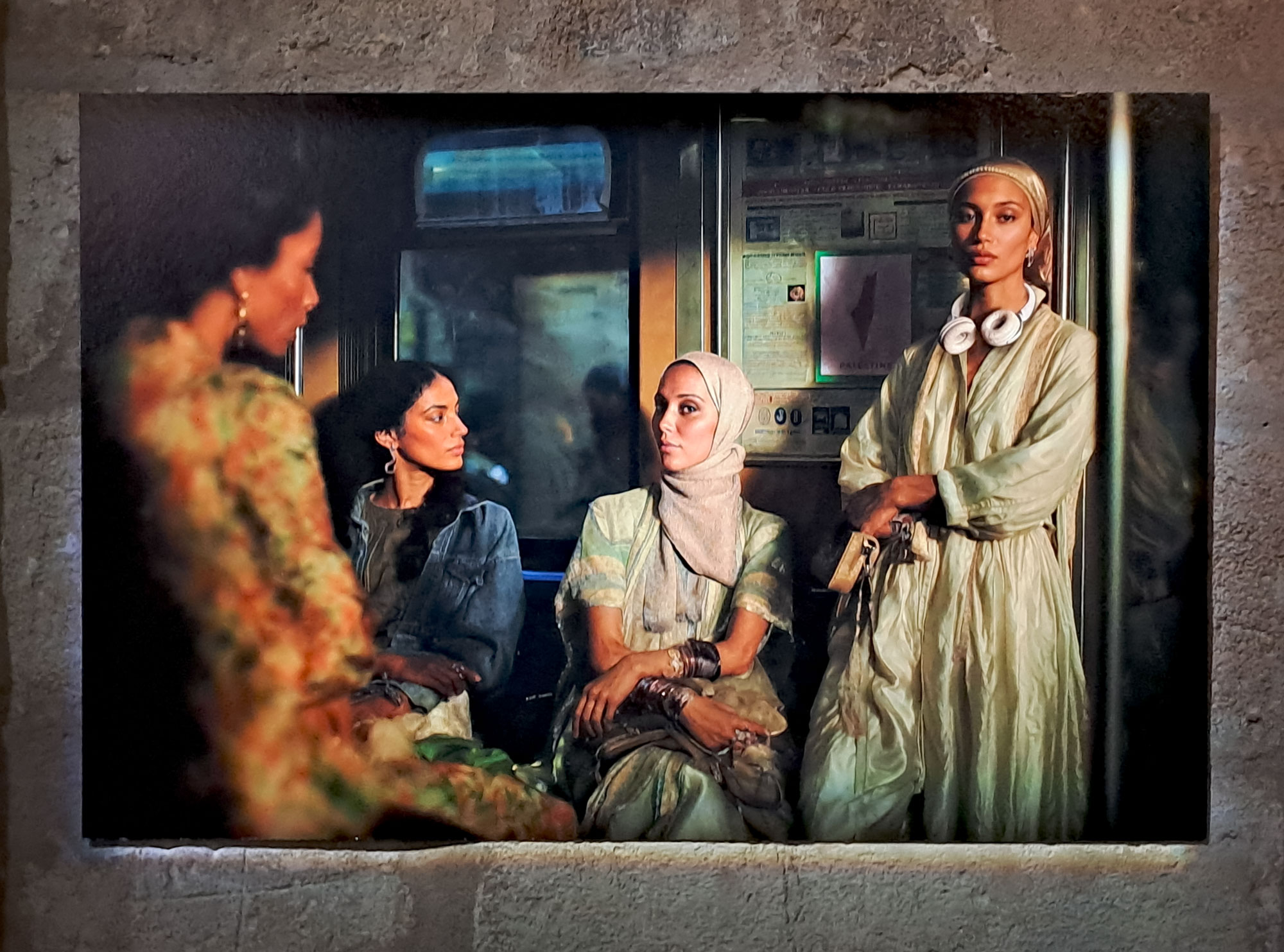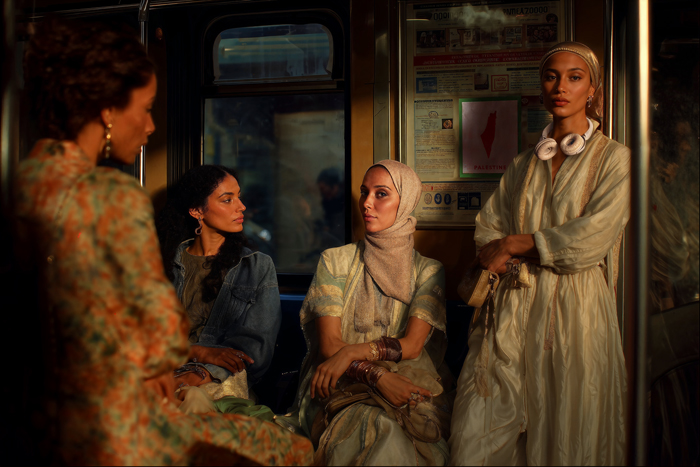Générations Y/Z
dans
le métro
parisien


Photographies et IA
impression sur Hahnemühle Baryta 325g, contrecollée sur Dibond 2 mm
101,15 x 67,43 cm
2025
أجيال Y/Z في مترو باريس
صور وفن الذكاء الاصطناعي
طباعة على ورق هاهنِه مولِه بارِيتا 325 غ، مُثبّتة على ديبوند 2 مم
101.15 × 67.43 سم
2025
تلتقط زهرة حساني ملامح جيلٍ كامل: جيلَي Y وZ كما تشير في العنوان. هل هو بورتريه ذاتي أم بورتريه جماعي؟ تلعب الفنانة على هذا الالتباس، إذ تُصوّر نفسها في الوسط، جالسة، محجّبة، موجّهة نظراتها نحو المتلقي. إلى يمينها، تنظر إليها شابة سمراء. وأخرى تُدير لنا ظهرها، ولا نلمح منها إلا طرفاً من الملامح. وإلى يسارها، تقف امرأة أخرى متكئة على عمود، وقد وضعت وشاحاً حريرياً على شعرها، تواجه المتلقي هي الأخرى، وسماعات الموسيقى حول عنقها. وإذا كان عنوان هذه الصورة اللافتة يضعنا في مترو باريس، فإن لوحات الإعلانات تُثير شكّنا.
إن اختيار تمثيل النساء وحدهن ليس أمراً عابراً. فالفضاء العام لهن؛ يظهرن فيه شجاعات، بديعات، فخورات، ومحوريات. بألوان هادئة، تتجلى جودة الملابس بوضوح، في إيماءة إلى الرسم الرومانسي والفلامندي، ولكن قبل كل شيء، في تمجيد وضعياتهن وقوامهن. تستدعي الفنانة صدى نساء الجزائر لدولاكروا وكذلك مشاهد فيرمير الداخلية من حيث كثافة الألوان وتوازن الوقفات، لكن هذه المرة، النساء ممثَّلات في الفضاء العام، متحررات من بيت مفروض. كما تُبرز الفنانة تنوّع أساليبهن في اللباس وشخصياتهن، جامعـةً بين الحجاب والأنوثة، سترة الجينز والفستان المزهر، أو الزي التقليدي مع السروال. وهي تروي أيضاً جيلاً ملتزماً، إذ تُدرج بخفة خريطة فلسطين تكاد تلامس الوضعية المتراخية لإحدى هؤلاء الشابات.
ترسم الفنانة بورتريهاً جماعياً أنثوياً معاصراً، يثير روابط الأخوة النسائية وكذلك سيولة هوياتنا المعقّدة والمتغيّرة. وتُبرز بشكل خاص روابط النَسَب والتوارث، فهنا تتعايش عدة أجيال. ومرة أخرى، تستدعي زهرة حساني الروابط التي تجمعها بأسلافها. إذ إنها، وقد غادرت الجزائر على عجل، واجهت في سن مبكرة تنافراً ثقافياً تجلّى أولاً في صمتٍ تام، ثم لاحقاً في أعمالها عبر توظيف الجسد والأداء الفني. فلكي نعثر على من يشبهنا، لا بد من ارتباطٍ بالذات، بالتاريخ، وبالإرث. وهي تسائل كل هذه الأبعاد دون أن تُجمّدها.
يلامس واقعية هذه الصورة، في قمة معاصرتها، إحساسٌ بأن الفنانة تلتقط مشهداً سينمائياً. بعض الدلالات الخاطفة – مثل التكوين، وكمال الوجوه – تُثير التساؤل وتخلق حالة من الالتباس. هل هي صورة التُقطت على حين غرة؟ أم تصوير سينمائي؟ أم مشهد مُعدّ؟
من الواضح أن drapés القماش تستحضر القرن التاسع عشر. ويبدو هذا التراكب الزمني بمثابة مفارقة ساخرة من « نساء الجزائر » لدولاكروا.
وبذلك، تُجسّد هذه الأعمال نقطة تحول في مسارها الفني. فاختيار تقنية التنفيذ بالذكاء الاصطناعي يعمّق هذا الأثر. تظهر الجزائريات في مترو باريس في اختلافاتهن وتفاصيلهن الدقيقة؛ عصيّات على الاختزال، متميّزات.
فضيلة ياهو | مؤرخة وناقدة فنية، دكتورة في تاريخ الفن.
Zohra Hassani capture le portrait d’une génération : la génération Y et Z précise-t-elle dans le titre. Est-ce un autoportrait ou un portrait collectif ? L’artiste joue de cette ambivalence, se représentant au centre, assise, voilée, son regard dirigé vers le spectateur. A sa droite, une jeune femme brune la regarde. Une autre encore nous tourne le dos, dont nous apercevons légèrement le profil. A sa gauche, une autre femme, adossée à une barre, debout, un tissu de soie sur les cheveux, fait là encore face au spectateur, casque de musique autour du cou. Si le titre de cette intrigante photographie nous place dans le métro parisien, les panneaux d’affichage nous en font douter.
Le choix de représenter uniquement des femmes n’est pas anodin. L’espace public leur appartient ; elles y sont vaillantes, sublimes, fières, centrales. Aux tons discrets, la qualité des vêtements est remarquable, clin d’œil à la peinture romantique et flamande, mais surtout, sublimation de leurs postures et de leurs statures. Elle convoque des réminiscences des Femmes d’Alger de Delacroix ainsi que des scènes d’intérieur de Vermeer au regard de la densité des couleurs et des poses, mais cette fois-ci, les femmes représentées sont dans l’espace public, émancipées d’un foyer imposé. En outre, l’artiste met en valeur la multiplicité de leurs styles vestimentaires et de leurs personnalités, alliant foulard et féminité, veste en jean et tenue fleurie ou traditionnelle avec le sarouel. Elle raconte aussi une génération engagée. Elle insère, en effet, subtilement une carte de la Palestine qui effleure presque la posture décontractée de l’une de ces jeunes femmes.
L’artiste brosse un portrait collectif exclusivement féminin et contemporain, soulevant les liens de sororité mais aussi la fluidité, complexe et mouvante, de nos identités. Elle rend surtout visible les liens de filiation et de transmission car ici plusieurs générations cohabitent. Et là encore, Zohra Hassani fait appel aux liens qui l’unissent à ses ancêtres. Quittant l’Algérie dans des conditions hâtives, elle est confrontée très jeune à une dissonance culturelle qui s’exprime d’abord par un mutisme puis plus tard, dans son œuvre, par l’emploi de son corps et par la performance. Or, pour pouvoir s’identifier à ceux et celles qui nous ressemblent ; la connexion à soi, à son histoire, à ses héritages est incontournable. Elle questionne ces dimensions-là tout en ne les figeant pas.
Le réalisme de cette photographie, au summum de la contemporanéité, côtoie l’impression que l’artiste saisit une scène de film. Certains indices furtifs -le cadrage, la perfection des visages – nous interrogent et installent une ambiguïté. Est-ce une photographie prise sur le vif ? Un tournage ? Une mise en scène ?
De toute évidence, les drapés rappellent le XIXème siècle. Cette superposition des époques apparaît comme un pied de nez aux Femmes d’Alger de Delacroix.
En cela, cette œuvre marque un tournant dans sa démarche artistique. Le choix de la technique d’exécution en IA accentue cet effet. Les Algériennes sont dans le métro parisien représentées dans leurs différences et dans leurs nuances ; irréductibles et distinguées.
Fadila Yahou | Historian and art critic, PhD in art history.
Generations
Y/Z
in the
Paris Metro
Photographs and AI
printed on Hahnemühle Baryta 325 g, mounted on 2 mm Dibond
101.15 × 67.43 cm
2025
Zohra Hassani captures the portrait of a generation—Generations Y and Z, as she specifies in the title. Is it a self-portrait or a collective portrait? The artist plays with this ambiguity, placing herself at the center, seated, veiled, her gaze directed toward the viewer. To her right, a young brunette woman looks at her. Another woman, with her back turned to us, reveals just a slight glimpse of her profile. To her left, another woman, leaning against a pole, stands with a silk scarf over her hair, once again facing the viewer, headphones around her neck. Although the title of this intriguing photograph situates us in the Paris metro, the advertising panels make us question it.
The choice to represent only women is far from incidental. The public space belongs to them; they appear valiant, sublime, proud, central. With discreet tones, the quality of the clothing is remarkable—a nod to Romantic and Flemish painting, but above all, a sublimation of their postures and statures. The work evokes echoes of Delacroix’s Women of Algiers and of Vermeer’s interior scenes, through its density of colors and its poses, yet here the women are situated in the public sphere, emancipated from any imposed domestic space. Moreover, the artist highlights the multiplicity of their clothing styles and personalities, blending headscarves and femininity, denim jackets with floral or traditional outfits such as the sarouel. She also narrates a committed generation. Indeed, she subtly inserts a map of Palestine that nearly grazes the relaxed posture of one of these young women.
The artist paints a collective portrait that is exclusively feminine and contemporary, raising notions of sisterhood but also the fluid, complex, and shifting nature of our identities. Above all, she brings to light the ties of lineage and transmission, for several generations coexist here. Once again, Zohra Hassani invokes the bonds that connect her to her ancestors. Having left Algeria under hurried circumstances, she was confronted at a very young age with a cultural dissonance that first manifested as muteness, and later, in her artistic work, through the use of her body and performance. Yet, to identify with those who resemble us, connection to oneself, to one’s history, and to one’s inheritances is essential. She questions these dimensions without ever freezing them.
The realism of this photograph—at the height of contemporaneity—brushes against the feeling that the artist has captured a film scene. Certain fleeting clues—the framing, the perfection of the faces—prompt us to question and establish ambiguity. Is this a candid photograph? A film set? A staged composition?
Evidently, the drapery recalls the 19th century. This layering of eras appears almost as a playful retort to Delacroix’s Women of Algiers.
In this sense, the work marks a turning point in her artistic approach. The choice of AI as the execution technique amplifies this effect. The Algerian women in the Paris metro are portrayed in their differences and nuances—irreducible and distinguished.
Fadila Yahou | Historian and art critic, PhD in art history.



